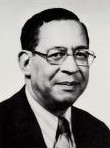Louis W. Roberts facts for kids
Quick facts for kids
Louis Wright Roberts
|
|
|---|---|
 |
|
| Born | September 1, 1913 |
| Died | November 3, 1995 (aged 82) |
| Education | Fisk University (BA) University of Michigan (MS) Massachusetts Institute of Technology (Ph.D.) |
| Occupation | Microwave physicist |
| Employer | NASA (1967–1970) United States Department of Transportation (1970–1989) |
Louis Wright Roberts (born September 1, 1913 – died November 3, 1995) was an amazing American scientist. He was a microwave physicist, which means he studied how tiny waves of energy (microwaves) work. These waves are used in things like cell phones and radar.
In the 1960s, he led the Microwave Laboratory at NASA's Electronics Research Center. Later, in the 1970s and 1980s, he worked for the United States Department of Transportation. He started as a top researcher and eventually became the director of a big research center there. He spent his career studying optics (light) and how to use microwaves in technology.
Contents
Early Life and Education
Louis Wright Roberts was born on September 1, 1913. His hometown was Jamestown, New York. His parents were Dora Catherine Wright and Louis Lorenzo Roberts.
He went to Fisk University and earned his first degree in 1935. Then, he got his master's degree from the University of Michigan in 1937. He continued his studies at the University of Michigan from 1939 to 1941. He finished his advanced degree at the Massachusetts Institute of Technology (MIT) in 1946. Later, in 1985, Fisk University gave him an honorary doctorate.
Career Highlights
Roberts started his career teaching at universities. From 1937 to 1939, he was an instructor at St. Augustine's University in Raleigh, North Carolina. He returned there from 1941 to 1942 as a physics professor.
He also taught physics at Howard University in Washington, D.C., from 1943 to 1944. While teaching, he researched optics and microwave electronics. Throughout his career, Roberts earned 11 patents for his inventions. He also wrote many articles about microwave theory.
Working with Companies
In 1944, Roberts joined Sylvania Electric Products. He worked as a manager in their tube division, focusing on research and development. He left Sylvania in 1950.
Around 1950 or 1951, Roberts briefly joined MIT as a researcher. In 1950, he also started his own company called Microwave Associates, Inc. This company later became known as M/A Com. He went on to start three more microwave research companies in Massachusetts: Bomac Labs, Metcom, and Elcon Labs.
Contributions to NASA and Transportation
In 1967, Roberts joined NASA. He became the chief of the Microwave Laboratory at NASA's Electronics Research Center in Cambridge, Massachusetts. He was one of the highest-ranking African-American staff members at NASA during the Apollo program.
Roberts told a newspaper that he joined NASA because of the amazing research opportunities. He also liked their advanced research facilities. His lab at NASA focused on using microwave technology for communication systems. They researched things like microwave antennas and solid state circuits.
Roberts stayed at NASA until 1970. After that, he joined the United States Department of Transportation. He continued his microwave research at the John A. Volpe National Transportation Systems Center. For several years, he studied how microwave technology could help with air traffic control. In 1977, he became the director of the Center. He retired in 1989.
Professional Groups
Roberts was a member of many important scientific groups. These included the American Association for the Advancement of Science and the American Physical Society. He was also part of the American Mathematical Society and the American Institute of Aeronautics and Astronautics.
He was a fellow of the Institute of Electrical and Electronics Engineers (IEEE). He also belonged to IEEE's Education Committee for a while. Roberts was also a member of Phi Beta Kappa, an honor society.
Personal Life
Louis Wright Roberts lived in Wakefield, Massachusetts, with his wife. They had two sons. He passed away on November 3, 1995.

